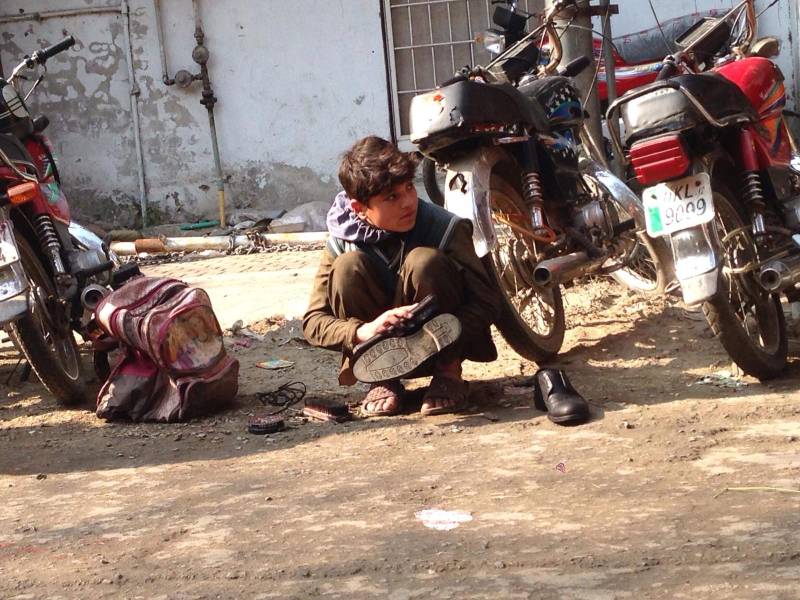
According to a 2012 survey, 12.5 million children in Pakistan are involved in child labour. Of the 25 million out of school children in 15 million are economically active.
A recent report by The Guardian which revealed that UK surgeons might be using surgical instruments made by children in Pakistan has sent shockwaves through Britain. According to the report, boys as young as 12 manufactured surgical instruments in Pakistan in appalling conditions without any safety equipment, and received less than a dollar a day for their work. Britain is the third largest buyer of Pakistani manufactured surgical equipment.
Not so, in Pakistan. Here, child labour is far from the focus of national attention. It is just now that the issue of child sexual abuse has gained at least some of the urgent attention that it requires – and that too after a particularly horrific and well-publicised case. But the exploitation of children for economic reasons remains far from the agenda. In fact, it is widely regarded not just as an accepted fact but as a necessity by many. This stems from the horrific class divides in society, and the difficulty in making basic ends meet amongst the working masses. In such circumstances, laboring children in poor families are often seen as a basic economic lifeline, and not just a supplementary source of income.
Pakistan’s constitution itself makes child labour illegal. However, this part of the constitution and other legislation aimed at keeping children away from hard labour has never been enforced. The 2013 Global Slavery Index revealed that the country had the third highest rates of child labour in the world. According to a survey conducted by the International Labour Organisation (ILO) in 2012, 12.5 million children in Pakistan are involved in child labour and 264,000 people were involved in domestic child labour. Additionally, 15 million out of the 25 million children out of school in Pakistan are economically active, making it highly unlikely that most of them or their parents will be able to prioritize education.
Ending child labour in Pakistan – or even significantly reducing it – will require a multifaceted approach. Widespread reforms and an increased budget will be required in the education sector, of course. Furthermore, the Pakistani media and civil society will have to bring the issue to the forefront.
However, this will not be easy. One obstacle, as mentioned earlier, is the widespread acceptance of child labour in society. But equally challenging will be the fact that most of Pakistan’s economy remains informal. This makes it very difficult to properly document the incidence of child labour – and even more, to effectively intervene against it. Photo credit: Shoaib Shah
A recent report by The Guardian which revealed that UK surgeons might be using surgical instruments made by children in Pakistan has sent shockwaves through Britain. According to the report, boys as young as 12 manufactured surgical instruments in Pakistan in appalling conditions without any safety equipment, and received less than a dollar a day for their work. Britain is the third largest buyer of Pakistani manufactured surgical equipment.
Not so, in Pakistan. Here, child labour is far from the focus of national attention. It is just now that the issue of child sexual abuse has gained at least some of the urgent attention that it requires – and that too after a particularly horrific and well-publicised case. But the exploitation of children for economic reasons remains far from the agenda. In fact, it is widely regarded not just as an accepted fact but as a necessity by many. This stems from the horrific class divides in society, and the difficulty in making basic ends meet amongst the working masses. In such circumstances, laboring children in poor families are often seen as a basic economic lifeline, and not just a supplementary source of income.
Pakistan’s constitution itself makes child labour illegal. However, this part of the constitution and other legislation aimed at keeping children away from hard labour has never been enforced. The 2013 Global Slavery Index revealed that the country had the third highest rates of child labour in the world. According to a survey conducted by the International Labour Organisation (ILO) in 2012, 12.5 million children in Pakistan are involved in child labour and 264,000 people were involved in domestic child labour. Additionally, 15 million out of the 25 million children out of school in Pakistan are economically active, making it highly unlikely that most of them or their parents will be able to prioritize education.
Ending child labour in Pakistan – or even significantly reducing it – will require a multifaceted approach. Widespread reforms and an increased budget will be required in the education sector, of course. Furthermore, the Pakistani media and civil society will have to bring the issue to the forefront.
However, this will not be easy. One obstacle, as mentioned earlier, is the widespread acceptance of child labour in society. But equally challenging will be the fact that most of Pakistan’s economy remains informal. This makes it very difficult to properly document the incidence of child labour – and even more, to effectively intervene against it. Photo credit: Shoaib Shah
